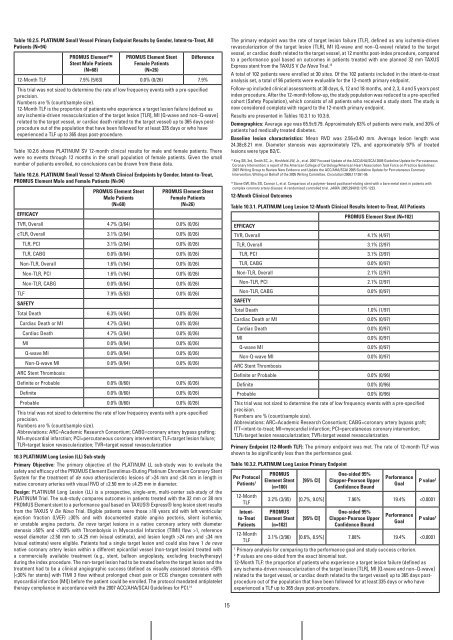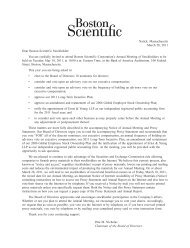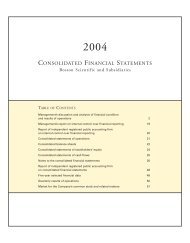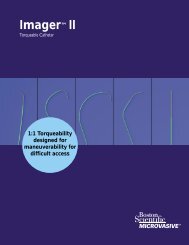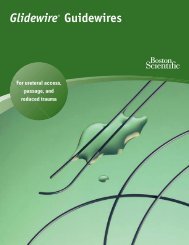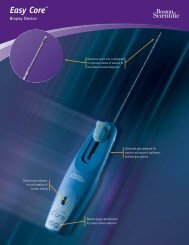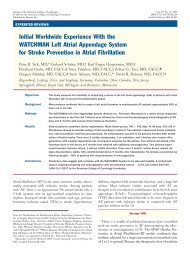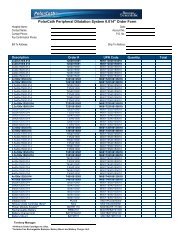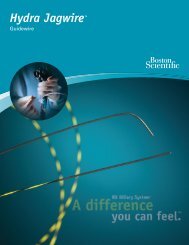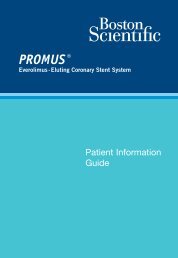PROMUS Element⢠Plus - Boston Scientific
PROMUS Element⢠Plus - Boston Scientific
PROMUS Element⢠Plus - Boston Scientific
Create successful ePaper yourself
Turn your PDF publications into a flip-book with our unique Google optimized e-Paper software.
Table 10.2.5. PLaTinUM Small vessel Primary Endpoint results by gender, intent-to-Treat, all<br />
Patients (n=94)<br />
PrOMUS Element<br />
Stent Male Patients<br />
(n=68)<br />
PrOMUS Element Stent<br />
female Patients<br />
(n=26)<br />
Difference<br />
12-Month TLF 7.9% (5/63) 0.0% (0/26) 7.9%<br />
This trial was not sized to determine the rate of low frequency events with a pre-specified<br />
precision.<br />
Numbers are % (count/sample size).<br />
12-Month TLF is the proportion of patients who experience a target lesion failure (defined as<br />
any ischemia-driven revascularization of the target lesion [TLR], MI [Q-wave and non–Q-wave]<br />
related to the target vessel, or cardiac death related to the target vessel) up to 365 days postprocedure<br />
out of the population that have been followed for at least 335 days or who have<br />
experienced a TLF up to 365 days post-procedure.<br />
Table 10.2.6 shows PLATINUM SV 12-month clinical results for male and female patients. There<br />
were no events through 12 months in the small population of female patients. Given the small<br />
number of patients enrolled, no conclusions can be drawn from these data.<br />
Table 10.2.6. PLaTinUM Small vessel 12-Month Clinical Endpoints by gender, intent-to-Treat,<br />
PrOMUS Element Male and female Patients (n=94)<br />
PrOMUS Element Stent<br />
Male Patients<br />
(n=68)<br />
PrOMUS Element Stent<br />
female Patients<br />
(n=26)<br />
EffiCaCY<br />
TVR, Overall 4.7% (3/64) 0.0% (0/26)<br />
cTLR, Overall 3.1% (2/64) 0.0% (0/26)<br />
TLR, PCI 3.1% (2/64) 0.0% (0/26)<br />
TLR, CABG 0.0% (0/64) 0.0% (0/26)<br />
Non-TLR, Overall 1.6% (1/64) 0.0% (0/26)<br />
Non-TLR, PCI 1.6% (1/64) 0.0% (0/26)<br />
Non-TLR, CABG 0.0% (0/64) 0.0% (0/26)<br />
TLF<br />
SafETY<br />
7.9% (5/63) 0.0% (0/26)<br />
Total Death 6.3% (4/64) 0.0% (0/26)<br />
Cardiac Death or MI 4.7% (3/64) 0.0% (0/26)<br />
Cardiac Death 4.7% (3/64) 0.0% (0/26)<br />
MI 0.0% (0/64) 0.0% (0/26)<br />
Q-wave MI 0.0% (0/64) 0.0% (0/26)<br />
Non-Q-wave MI<br />
ARC Stent Thrombosis<br />
0.0% (0/64) 0.0% (0/26)<br />
Definite or Probable 0.0% (0/60) 0.0% (0/26)<br />
Definite 0.0% (0/60) 0.0% (0/26)<br />
Probable 0.0% (0/60) 0.0% (0/26)<br />
This trial was not sized to determine the rate of low frequency events with a pre-specified<br />
precision.<br />
Numbers are % (count/sample size).<br />
Abbreviations: ARC=Academic Research Consortium; CABG=coronary artery bypass grafting;<br />
MI=myocardial infarction; PCI=percutaneous coronary intervention; TLF=target lesion failure;<br />
TLR=target lesion revascularization; TVR=target vessel revascularization<br />
10.3 PLaTinUM Long Lesion (LL) Sub-study<br />
Primary Objective: The primary objective of the PLATINUM LL sub-study was to evaluate the<br />
safety and efficacy of the <strong>PROMUS</strong> Element Everolimus-Eluting Platinum Chromium Coronary Stent<br />
System for the treatment of de novo atherosclerotic lesions of >24 mm and ≤34 mm in length in<br />
native coronary arteries with visual RVD of ≥2.50 mm to ≤4.25 mm in diameter.<br />
Design: PLATINUM Long Lesion (LL) is a prospective, single-arm, multi-center sub-study of the<br />
PLATINUM Trial. The sub-study compares outcomes in patients treated with the 32 mm or 38 mm<br />
<strong>PROMUS</strong> Element stent to a performance goal based on TAXUS® Express® long lesion stent results<br />
from the TAXUS V De Novo Trial. Eligible patients were those ≥18 years old with left ventricular<br />
ejection fraction (LVEF) ≥30% and with documented stable angina pectoris, silent ischemia,<br />
or unstable angina pectoris. De novo target lesions in a native coronary artery with diameter<br />
stenosis ≥50% and 1, reference<br />
vessel diameter ≥2.50 mm to ≤4.25 mm (visual estimate), and lesion length >24 mm and ≤34 mm<br />
(visual estimate) were eligible. Patients had a single target lesion and could also have 1 de novo<br />
native coronary artery lesion within a different epicardial vessel (non-target lesion) treated with<br />
a commercially available treatment (e.g., stent, balloon angioplasty, excluding brachytherapy)<br />
during the index procedure. The non-target lesion had to be treated before the target lesion and the<br />
treatment had to be a clinical angiographic success (defined as visually assessed stenosis


